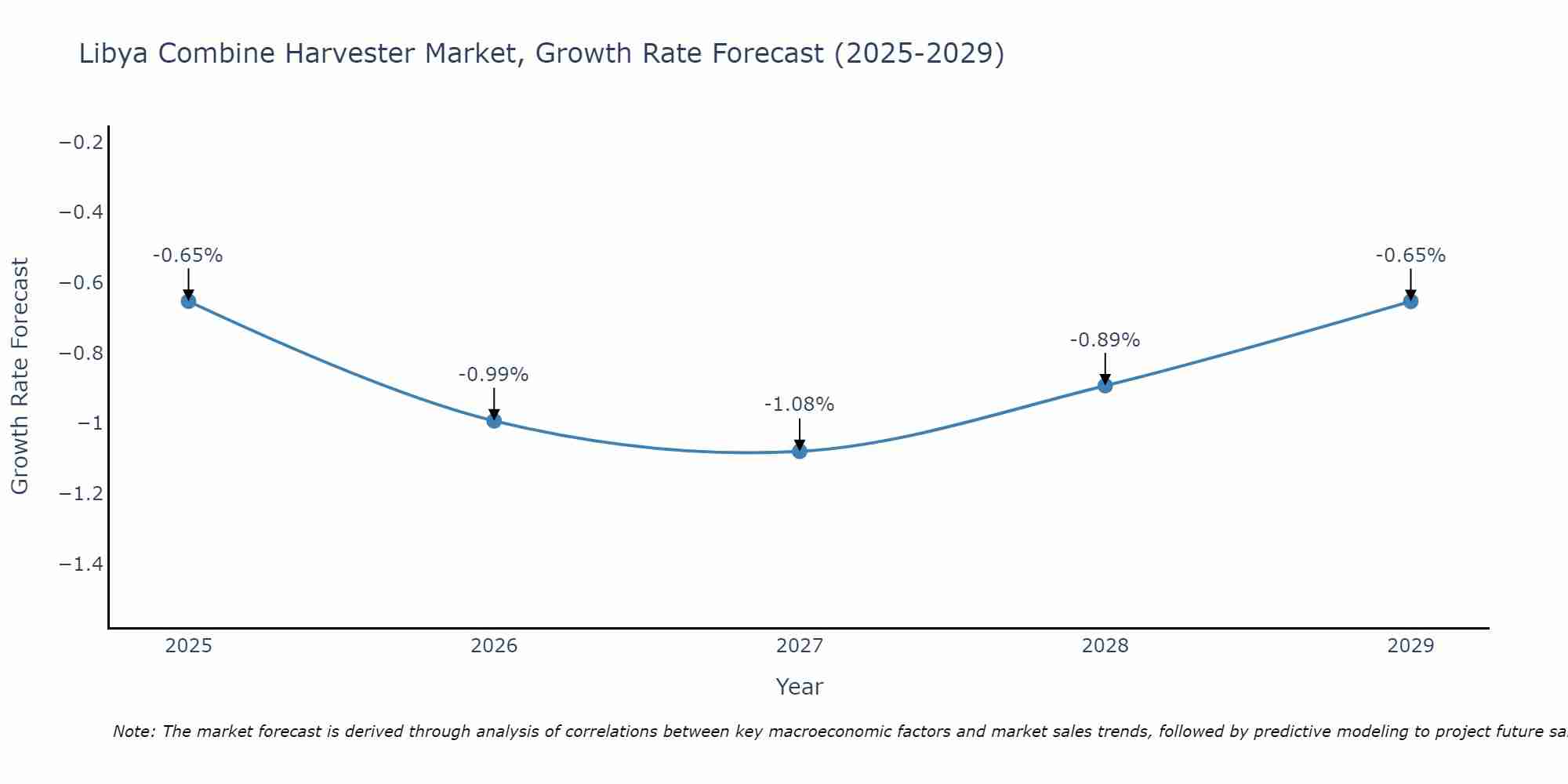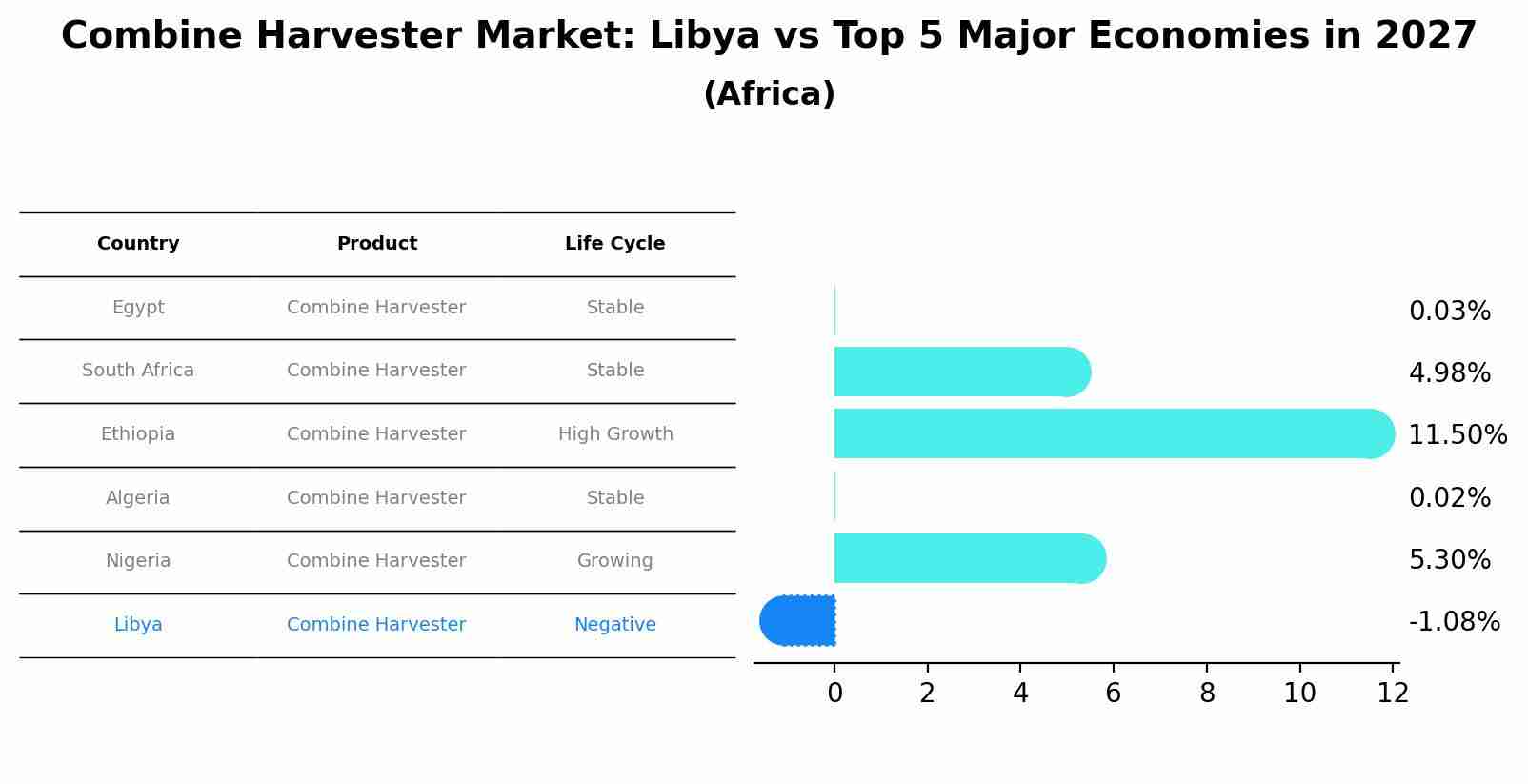Libya Combine Harvester Market (2025-2031) | Revenue, Industry, Forecast, Segmentation, Size, Outlook, Share, Value, Trends, Growth, Analysis & Companies
| Product Code: ETC5398261 | Publication Date: Nov 2023 | Updated Date: Aug 2025 | Product Type: Market Research Report | |
| Publisher: 6Wresearch | Author: Ravi Bhandari | No. of Pages: 60 | No. of Figures: 30 | No. of Tables: 5 |
Libya Combine Harvester Market Size Growth Rate
The Libya Combine Harvester Market is projected to witness mixed growth rate patterns during 2025 to 2029. Beginning strongly at -0.65% in 2025, growth softens to -0.65% in 2029.

Combine Harvester Market: Libya vs Top 5 Major Economies in 2027 (Africa)
By 2027, Libya's Combine Harvester market is forecasted to achieve a negative growth rate of -1.08%, with Egypt leading the Africa region, followed by South Africa, Ethiopia, Algeria and Nigeria.

Key Highlights of the Report:
- Libya Combine Harvester Market Outlook
- Market Size of Libya Combine Harvester Market, 2024
- Forecast of Libya Combine Harvester Market, 2031
- Historical Data and Forecast of Libya Combine Harvester Revenues & Volume for the Period 2021-2031
- Libya Combine Harvester Market Trend Evolution
- Libya Combine Harvester Market Drivers and Challenges
- Libya Combine Harvester Price Trends
- Libya Combine Harvester Porter`s Five Forces
- Libya Combine Harvester Industry Life Cycle
- Historical Data and Forecast of Libya Combine Harvester Market Revenues & Volume By Cutting Width for the Period 2021-2031
- Historical Data and Forecast of Libya Combine Harvester Market Revenues & Volume By Small Size Combine Harvester for the Period 2021-2031
- Historical Data and Forecast of Libya Combine Harvester Market Revenues & Volume By Large Size Combine Harvester for the Period 2021-2031
- Historical Data and Forecast of Libya Combine Harvester Market Revenues & Volume By Type for the Period 2021-2031
- Historical Data and Forecast of Libya Combine Harvester Market Revenues & Volume By Wheel Type Combine Harvester for the Period 2021-2031
- Historical Data and Forecast of Libya Combine Harvester Market Revenues & Volume By Crawler Type Combine Harvester for the Period 2021-2031
- Historical Data and Forecast of Libya Combine Harvester Market Revenues & Volume By Power Source for the Period 2021-2031
- Historical Data and Forecast of Libya Combine Harvester Market Revenues & Volume By Tractor Pulled/PTO Powered Combine Harvester for the Period 2021-2031
- Historical Data and Forecast of Libya Combine Harvester Market Revenues & Volume By Self-Propelled Combine Harvester for the Period 2021-2031
- Libya Combine Harvester Import Export Trade Statistics
- Market Opportunity Assessment By Cutting Width
- Market Opportunity Assessment By Type
- Market Opportunity Assessment By Power Source
- Libya Combine Harvester Top Companies Market Share
- Libya Combine Harvester Competitive Benchmarking By Technical and Operational Parameters
- Libya Combine Harvester Company Profiles
- Libya Combine Harvester Key Strategic Recommendations
Frequently Asked Questions About the Market Study (FAQs):
1 Executive Summary |
2 Introduction |
2.1 Key Highlights of the Report |
2.2 Report Description |
2.3 Market Scope & Segmentation |
2.4 Research Methodology |
2.5 Assumptions |
3 Libya Combine Harvester Market Overview |
3.1 Libya Country Macro Economic Indicators |
3.2 Libya Combine Harvester Market Revenues & Volume, 2021 & 2031F |
3.3 Libya Combine Harvester Market - Industry Life Cycle |
3.4 Libya Combine Harvester Market - Porter's Five Forces |
3.5 Libya Combine Harvester Market Revenues & Volume Share, By Cutting Width, 2021 & 2031F |
3.6 Libya Combine Harvester Market Revenues & Volume Share, By Type, 2021 & 2031F |
3.7 Libya Combine Harvester Market Revenues & Volume Share, By Power Source, 2021 & 2031F |
4 Libya Combine Harvester Market Dynamics |
4.1 Impact Analysis |
4.2 Market Drivers |
4.2.1 Government support and subsidies for agriculture mechanization |
4.2.2 Increasing demand for efficient farming practices to enhance productivity |
4.2.3 Growing adoption of modern agricultural technologies in Libya |
4.3 Market Restraints |
4.3.1 High initial investment cost of combine harvesters |
4.3.2 Lack of awareness and technical expertise among farmers about combine harvester usage |
4.3.3 Limited availability of financing options for purchasing combine harvesters |
5 Libya Combine Harvester Market Trends |
6 Libya Combine Harvester Market Segmentations |
6.1 Libya Combine Harvester Market, By Cutting Width |
6.1.1 Overview and Analysis |
6.1.2 Libya Combine Harvester Market Revenues & Volume, By Small Size Combine Harvester, 2021-2031F |
6.1.3 Libya Combine Harvester Market Revenues & Volume, By Large Size Combine Harvester, 2021-2031F |
6.2 Libya Combine Harvester Market, By Type |
6.2.1 Overview and Analysis |
6.2.2 Libya Combine Harvester Market Revenues & Volume, By Wheel Type Combine Harvester, 2021-2031F |
6.2.3 Libya Combine Harvester Market Revenues & Volume, By Crawler Type Combine Harvester, 2021-2031F |
6.3 Libya Combine Harvester Market, By Power Source |
6.3.1 Overview and Analysis |
6.3.2 Libya Combine Harvester Market Revenues & Volume, By Tractor Pulled/PTO Powered Combine Harvester, 2021-2031F |
6.3.3 Libya Combine Harvester Market Revenues & Volume, By Self-Propelled Combine Harvester, 2021-2031F |
7 Libya Combine Harvester Market Import-Export Trade Statistics |
7.1 Libya Combine Harvester Market Export to Major Countries |
7.2 Libya Combine Harvester Market Imports from Major Countries |
8 Libya Combine Harvester Market Key Performance Indicators |
8.1 Average age of combine harvesters in use |
8.2 Adoption rate of precision farming techniques |
8.3 Percentage of arable land using mechanized harvesting techniques |
8.4 Average yield per hectare of crops harvested using combine harvesters |
8.5 Rate of growth in the number of authorized combine harvester dealerships in Libya |
9 Libya Combine Harvester Market - Opportunity Assessment |
9.1 Libya Combine Harvester Market Opportunity Assessment, By Cutting Width, 2021 & 2031F |
9.2 Libya Combine Harvester Market Opportunity Assessment, By Type, 2021 & 2031F |
9.3 Libya Combine Harvester Market Opportunity Assessment, By Power Source, 2021 & 2031F |
10 Libya Combine Harvester Market - Competitive Landscape |
10.1 Libya Combine Harvester Market Revenue Share, By Companies, 2024 |
10.2 Libya Combine Harvester Market Competitive Benchmarking, By Operating and Technical Parameters |
11 Company Profiles |
12 Recommendations | 13 Disclaimer |
- Single User License$ 1,995
- Department License$ 2,400
- Site License$ 3,120
- Global License$ 3,795
Search
Thought Leadership and Analyst Meet
Our Clients
Related Reports
- Germany Breakfast Food Market (2026-2032) | Industry, Share, Growth, Size, Companies, Value, Analysis, Revenue, Trends, Forecast & Outlook
- Australia Briquette Market (2025-2031) | Growth, Size, Revenue, Forecast, Analysis, Trends, Value, Share, Industry & Companies
- Vietnam System Integrator Market (2025-2031) | Size, Companies, Analysis, Industry, Value, Forecast, Growth, Trends, Revenue & Share
- ASEAN and Thailand Brain Health Supplements Market (2025-2031) | Strategy, Consumer Insights, Analysis, Investment Trends, Opportunities, Growth, Size, Share, Industry, Revenue, Segments, Value, Segmentation, Supply, Forecast, Restraints, Outlook, Competition, Drivers, Trends, Demand, Pricing Analysis, Competitive, Strategic Insights, Companies, Challenges
- ASEAN Bearings Market (2025-2031) | Strategy, Consumer Insights, Analysis, Investment Trends, Opportunities, Growth, Size, Share, Industry, Revenue, Segments, Value, Segmentation, Supply, Forecast, Restraints, Outlook, Competition, Drivers, Trends, Demand, Pricing Analysis, Competitive, Strategic Insights, Companies, Challenges
- Europe Flooring Market (2025-2031) | Outlook, Share, Industry, Trends, Forecast, Companies, Revenue, Size, Analysis, Growth & Value
- Saudi Arabia Manlift Market (2025-2031) | Outlook, Size, Growth, Trends, Companies, Industry, Revenue, Value, Share, Forecast & Analysis
- Uganda Excavator, Crane, and Wheel Loaders Market (2025-2031) | Strategy, Consumer Insights, Analysis, Investment Trends, Opportunities, Growth, Size, Share, Industry, Revenue, Segments, Value, Segmentation, Supply, Forecast, Restraints, Outlook, Competition, Drivers, Trends, Demand, Pricing Analysis, Competitive, Strategic Insights, Companies, Challenges
- Rwanda Excavator, Crane, and Wheel Loaders Market (2025-2031) | Strategy, Consumer Insights, Analysis, Investment Trends, Opportunities, Growth, Size, Share, Industry, Revenue, Segments, Value, Segmentation, Supply, Forecast, Restraints, Outlook, Competition, Drivers, Trends, Demand, Pricing Analysis, Competitive, Strategic Insights, Companies, Challenges
- Kenya Excavator, Crane, and Wheel Loaders Market (2025-2031) | Strategy, Consumer Insights, Analysis, Investment Trends, Opportunities, Growth, Size, Share, Industry, Revenue, Segments, Value, Segmentation, Supply, Forecast, Restraints, Outlook, Competition, Drivers, Trends, Demand, Pricing Analysis, Competitive, Strategic Insights, Companies, Challenges
Industry Events and Analyst Meet
Whitepaper
- Middle East & Africa Commercial Security Market Click here to view more.
- Middle East & Africa Fire Safety Systems & Equipment Market Click here to view more.
- GCC Drone Market Click here to view more.
- Middle East Lighting Fixture Market Click here to view more.
- GCC Physical & Perimeter Security Market Click here to view more.
6WResearch In News
- Doha a strategic location for EV manufacturing hub: IPA Qatar
- Demand for luxury TVs surging in the GCC, says Samsung
- Empowering Growth: The Thriving Journey of Bangladesh’s Cable Industry
- Demand for luxury TVs surging in the GCC, says Samsung
- Video call with a traditional healer? Once unthinkable, it’s now common in South Africa
- Intelligent Buildings To Smooth GCC’s Path To Net Zero


















